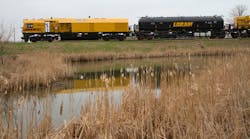LORAM Stays on Track With Real-Time and Historical Mobile Data Collection and Reporting
Railway volume has increased substantially in recent years due to an increase in oil prices, among other environmental and economic factors. Today, tracks can be one of the most costly assets for railway companies, but with regular maintenance activities, like rail grinding, track longevity can be extended by two or three times.
All railways face challenges of maintaining track in remote locations – deserts, mountains, underground, etc. – with limited resources and shortened work blocks. Rail grinding is an essential piece of an effective maintenance plan. It involves grinding off rail to remove cracks and match the desired rail profile. This prevents potentially dangerous breaks in the rail and ensures trains move most efficiently along the tracks.
Located in Hamel, Minnesota, LORAM Maintenance of the Way Inc. is a leading supplier of track maintenance machinery. LORAM was founded in 1954, building its business on helping railway companies preserve their lines by manufacturing machines that bring maintenance to the rail. The company has been designing, manufacturing and operating rail grinders since 1976.
Incorporating high power, flexible grinding modules with patented control systems, rail grinders are essentially advanced factories on wheels. LORAM is constantly looking for new ways to save its customers money by maximizing efficiency, productivity and value from the rail asset.
To help streamline maintenance activities and improve visualization into operations, the company implemented a mobile remote-monitoring solution from Rockwell Automation and Microsoft.®
Challenge
LORAM rail grinders are highly automated machines, incorporating many different technological components and software. Each rail grinder requires an on-machine crew of approximately 10 that is responsible for operating the machines. Engineering and troubleshooting of the machines is managed by a team at the company headquarters in Hamel.
In the past, if an issue occurred or corrective action for a component failure was required, the crew would have to contact the maintenance technicians at LORAM headquarters to diagnose the issue. Because all of the data from the control systems resided on the machines, the technical support staff in Hamel was occasionally unable to diagnosis the problem without travelling to the machine.
“Without easy remote access to machine data, troubleshooting and diagnostics on machines in the field were time consuming and difficult, relying on the technical support staff to walk the on-site team through the issue and potential fixes,” said Nathan Moyer, field application technician for LORAM. “Larger issues would require the technical staff to travel to the grinder, extending downtime further.”
One day of downtime for a rail grinder is very costly for the company, even before parts and service costs are added. In addition, performance data wasn’t automatically collected through a centralized application, and was only accessible on-machine for 30 days. With machines in the field for many years or their entire lifecycle, maintenance technicians from headquarters needed to proactively retrieve data from the machines, as the on-machine historians held up-to 30 days of data. When there are more than 80 grinding machines out in the field – collecting this type of data required resources that could be used elsewhere. “Retrieving data remotely was a time-consuming task – not to mention, all data was in PLC code requiring it to be retrieved and analyzed by a technician who could properly interpret the data,” said Moyer.
Locating necessary information for troubleshooting that used to take a significant amount of my time, now only takes a few minutes— Nathan Moyer, field application technician, Loram
The data-log format wasn’t easily readable, customizable or searchable. Due to the difficulty in understanding the data and manually developing reports, reports were only developed on an ad-hoc basis. We developed reports based on issues we had at any given moment, not for predictive maintenance,” said Moyer.
Solution
Partnering with Rockwell Automation, LORAM implemented a manufacturing-intelligence system with remote-monitoring capabilities on its newest line of rail grinders – the LORAM RG400 series.
Allen-Bradley® ControlLogix® programmable automation controllers (PACs) manage machine automation with EtherNet/IP™ as the industrial communications backbone of the solution to provide seamless communication between the various pieces of equipment on the rail grinder.
Leveraging FactoryTalk® Historian software, LORAM remotely collects critical performance data from each rail grinder for real-time troubleshooting, maintenance and electronic reporting. Data points cover component temperature, engine run hours, historical generator loads and other important KPIs. Microsoft Surface™ tablets running the FactoryTalk VantagePoint® mobile app allow LORAM technicians to see machine data and troubleshoot issues from any location in real time.
“Now when I get a call about an equipment issue on the rail grinders, I can pull up easy-to-read dashboards and trend reports to dig deeper into data logs from my office – at home or on the road using the Microsoft Surface tablet with wireless connectivity. I can also tap into all necessary on-machine HMIs via FactoryTalk View software,” said Moyer. “Locating necessary information for troubleshooting that used to take a significant amount of my time, now only takes a few minutes.”
Using FactoryTalk Historian software and the FactoryTalk VantagePoint GPS time module, LORAM now tracks North American rail grinders through wireless connections, and displays machine location and status on Google Maps™ mapping service. The GPS mapping capability provides off-site technicians visibility of each grinder at all times. Technicians have the ability to see a street level view of each machine and link to individual machine KPI dashboards.
Results
Remote access to real-time machine data provides LORAM rail grinder technicians the ability to see issues as they happen and to proactively plan for similar issues that could occur in the future. Utilizing remote diagnostics for predictive-maintenance activities has reduced mean time to failure while increasing mean time to repair.
The control systems used on the RG400 series of rail grinders produce more than 100,000 data tags. Technicians have visibility into 45,000 tags via HMI screens and can collect up to 2,100 data tags of their choosing per electronic report.
“Our new remote capabilities have significantly reduced troubleshooting time and costs. Mobility provided by our Microsoft Surface tablets and the FactoryTalk VantagePoint KPI mobile app can prevent considerable downtime – saving us significant costs in downtime avoided,” said Moyer. “Additionally, this level of remote access gives LORAM and our customers a competitive edge.”
New, electronic reporting makes accessing, searching and analyzing data much easier on the new system. Each rail grinder can now hold 137 days of local data storage before upload. All critical performance data can be retrieved from the field electronically and quickly. Technicians and engineers now have the time to focus their efforts on monitoring and implementing proactive maintenance or even implementing next-generation design changes. This means LORAM can re-allocate resources for improved efficiency and increased uptime across its fleets.
The results mentioned above are specific to LORAM Maintenance of the Way Inc.’s use of Rockwell Automation products and services in conjunction with other products. Specific results may vary for other customers.




